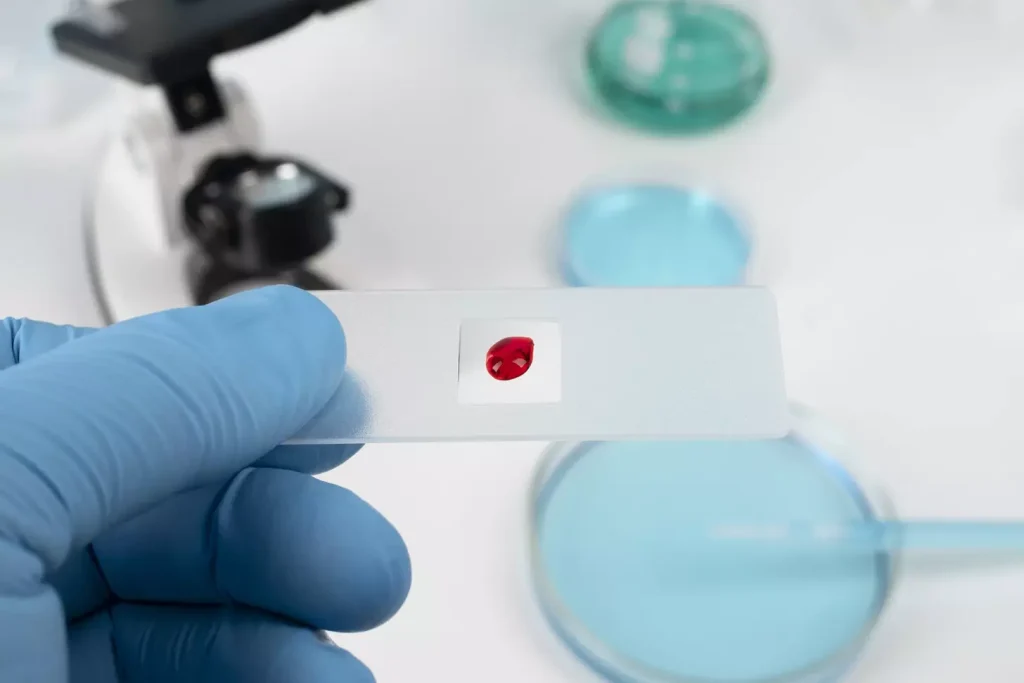Last Updated on October 20, 2025 by Bilal Hasdemir

The term aplastic comes from Greek. It means tissues or organs that don’t grow or heal right. In medicine, aplastic describes when the body can’t make new cells.
At Liv Hospital, we know how important clear medical diagnoses are. Aplastic anemia, for example, affects 2 in 1 million Europeans. It happens when the bone marrow can’t make enough blood cells. We’ll look into what aplastic conditions mean and their health effects. This will help those looking for healthcare worldwide.

To understand “aplastic,” we need to look at its roots. The word comes from Greek. “A-” means “without” and “plastikos” means “able to be molded or formed.”
The Greek word “plastikos” is about molding or forming. Adding “a-” to it means without this ability. This is key to understanding aplastic meaning in medicine.
The word “aplastic” comes from combining these Greek roots. It describes situations where tissue or cells can’t form. Knowing this helps doctors and patients understand aplastic medical term better.
“Aplastic” has been used in medicine for a long time. It was first used to describe when tissue didn’t grow or heal. Now, it’s used for conditions like aplastic anemia, where the bone marrow can’t make blood cells.
| Term | Definition | Historical Context |
|---|---|---|
| Aplastic | Relating to a condition where tissue or cells fail to form or develop. | Derived from Greek roots “a-” and “plastikos.” |
| Aplasia | A condition characterized by the failure of an organ or tissue to develop. | Used in medical literature to describe developmental failures. |
Knowing how “aplastic” has evolved helps us understand its role today. Its aplastic definition is about when new tissue can’t form. This is important for diagnosing and treating many health issues.

In medicine, ‘aplastic’ means there’s no or little growth of cells or tissues. It’s key to grasp this term for many health issues. These issues happen when cells, tissues, or organs don’t grow right.
The main idea of ‘aplastic’ is when growth stops. It’s often linked to problems in the bone marrow, blood cells, or other important tissues. For example, aplastic anemia is when the bone marrow can’t make blood cells, causing serious health problems.
Aplastic issues can show up in many ways and affect different body parts. The main uses of this term are in:
Knowing what ‘aplastic’ means helps doctors diagnose and treat these issues better.
It’s important to know the difference between ‘aplastic’ and ‘aplasia.’ Both deal with growth issues, but they mean different things. Aplasia usually means a tissue or organ was never formed or didn’t grow right from birth. ‘Aplastic’ means growth stopped or is badly damaged, which can happen at birth or later.
For example, aplasia of the bone marrow is a birth defect where the bone marrow is missing or not fully formed. But aplastic anemia is when the bone marrow gets damaged later, often due to illness or treatment.
To make things clearer, here’s a comparison:
| Term | Definition | Typical Context |
|---|---|---|
| Aplastic | Failure or cessation of normal development | Acquired or secondary conditions, e.g., aplastic anemia |
| Aplasia | Congenital absence or failure of development | Congenital conditions, e.g., aplasia of the radius |
Understanding these differences helps doctors give better diagnoses and treatments.
Aplastic conditions are disorders where certain body parts or organs don’t develop right. They can affect different parts of the body. Doctors diagnose them based on specific criteria.
We’ll look at how doctors diagnose aplastic disorders. We’ll focus on what makes these conditions unique. Knowing this helps doctors diagnose and treat them better.
To diagnose aplastic disorders, doctors do a thorough check. This includes lab tests and clinical exams. For example, aplastic anemia is diagnosed when the bone marrow fails.
These tests help doctors find the cause of aplastic conditions. Then, they can plan the right treatment.
Aplastic conditions mean cells or tissues can’t grow or work right. For aplastic anemia, the bone marrow can’t make enough blood cells. This leads to anemia, infections, and bleeding.
The signs of aplastic conditions vary by disorder. But, common traits include:
Knowing these traits is key to finding effective treatments. It helps improve patient care.
Aplastic anemia is a rare but serious condition. It affects the bone marrow’s ability to make blood cells. This leads to a lack of red blood cells, white blood cells, and platelets.
The immune system attacks the bone marrow in aplastic anemia. This attack reduces the number of stem cells. As a result, the body makes fewer blood cells, causing anemia, infections, and bleeding.
The exact reasons for aplastic anemia are complex. Autoimmune responses, toxins, and certain medications can cause it. Often, the cause is unknown.
Aplastic anemia affects about 2 in 1 million people in Europe each year. The rate varies worldwide, with different areas having different rates.
It can happen to anyone, but it’s more common in young adults and the elderly. Dan Chapman’s story shows the impact of aplastic anemia. It emphasizes the need for awareness and support.
The study of aplastic anemia shows:
Knowing these facts helps in finding better treatments and improving care for patients.
Aplastic conditions affect many parts of the body, not just the blood. They are found in different organ systems and bring unique challenges. We will look at other important “aplastic” medical conditions, including those in blood disorders and changes in organs.
An aplastic crisis is a serious issue for people with certain blood disorders, like sickle cell disease. It’s often caused by infections, like parvovirus B19, which stops the bone marrow from making new red blood cells. This leads to a quick drop in hemoglobin levels.
This condition needs quick medical help because it can cause severe anemia and other serious problems.
To diagnose an aplastic crisis, doctors watch the patient’s hemoglobin and reticulocyte count. The treatment usually includes blood transfusions to help manage the anemia until the bone marrow starts making red blood cells again.
Aplastic changes can happen in different parts of the body, causing various symptoms. For example, aplastic kidney or renal aplasia means one or both kidneys are not fully developed or missing. This can greatly affect kidney function.
Similar changes in the lungs, called pulmonary aplasia, can lead to underdeveloped or missing lung tissue. This impacts breathing.
Diagnosing these conditions often involves imaging tests like ultrasound, CT scans, or MRI. These help doctors see how severe the aplastic changes are. Treatment plans vary based on the organ affected and how severe the condition is. They can range from supportive care to surgery.
It’s key for healthcare professionals to know how “aplastic” is used in medical terms. This helps them make accurate diagnoses and give the right care to patients with these conditions.
In medical terms, knowing the difference between aplasia and aplastic is key. Both deal with growth issues, but they mean different things for treatment. It’s important for doctors to understand these differences.
Aplasia means an organ or tissue didn’t fully develop. It can happen for many reasons, like genetic problems or environmental factors. For example, aplasia cutis congenita is when a baby is born without skin on their scalp.
The word “aplasia” is used in many medical fields. In orthopedics, it might describe a limb or bone not growing right. Knowing about aplasia helps doctors diagnose and treat these issues.
Aplasia is about tissues or organs not growing right. On the other hand, aplastic conditions mean an organ or tissue can’t work because it lacks cells. For example, aplastic anemia is when the bone marrow can’t make blood cells.
The main difference is in what’s not working. Aplasia is about not having something, while aplastic is about something not working right. Doctors need to know this to give the right treatment.
By understanding the difference between aplasia and aplastic, doctors can make better plans for treatment. This helps patients get better care and improves health outcomes.
Aplastic conditions come from a mix of genetic and environmental factors. Aplastic anemia can be caused by chemicals, radiation, or viruses. Knowing these causes helps doctors diagnose and treat better.
Genetics are key in aplastic conditions. Disorders like Fanconi anemia raise the risk of aplastic anemia. These genes affect how the bone marrow makes blood cells.
Key genetic factors include:
Environmental factors also play a big role. Chemicals like pesticides and benzene increase aplastic anemia risk. Radiation, from work or medical treatments, harms the bone marrow too.
Notable environmental triggers include:
“Exposure to certain environmental toxins can significantly increase the risk of developing aplastic anemia.”
-Hematologist
Many aplastic cases have no known cause. These cases are hard to diagnose and treat. Scientists keep looking for what might be behind them.
Knowing what causes aplastic conditions is vital for treatment. Doctors can tailor care by understanding genetic and environmental risks.
Diagnosing aplastic conditions requires a detailed approach. This includes lab tests, imaging, and clinical checks. Getting the diagnosis right is key to treating these conditions well.
Laboratory tests are essential in diagnosing aplastic disorders. Some important tests are:
These tests help figure out how severe and what type of aplastic condition it is. They guide treatment choices.
Imaging and tissue sampling are also key in diagnosis.
Studies like X-rays, CT scans, or MRI scans check internal organs and find any problems.
Biopsies give important info on cells and confirm the diagnosis.
Differential diagnosis is a vital step in diagnosing aplastic disorders. It’s about telling aplastic conditions apart from other similar health issues.
Doctors look at medical history, symptoms, and test results to make an accurate diagnosis.
A detailed differential diagnosis helps rule out other possible causes. This ensures patients get the right treatment for their condition.
It’s important for healthcare providers and patients to know about aplastic condition treatments. Aplastic conditions, like aplastic anemia, need a detailed treatment plan. This plan should tackle the root causes and symptoms.
Medicine is key in treating aplastic conditions. It often involves using drugs to calm down the immune system’s attack on the bone marrow.
The right medicine depends on how severe the condition is and the patient’s health.
Stem cell and bone marrow transplants can be lifesaving for aplastic anemia and other severe conditions. They replace damaged bone marrow with healthy stem cells from a donor.
Dan Chapman’s story shows how vital finding a matching stem cell donor is. It highlights the transplant’s life-saving role.
| Treatment Modality | Description | Indications |
|---|---|---|
| Immunosuppressive Therapy | Suppresses the immune system to reduce its attack on the bone marrow | Aplastic anemia, other aplastic conditions |
| Stem Cell Transplantation | Replaces damaged bone marrow with healthy stem cells | Severe aplastic anemia, failed immunosuppressive therapy |
Supportive care is vital for managing aplastic conditions. It aims to ease symptoms and improve life quality.
Knowing the treatment options helps healthcare providers create tailored plans. These plans meet each patient’s specific needs.
It’s important to know the differences in medical terms like “aplagia” and “applasia.” These terms are connected to “aplastic” but have their own meanings in medicine.
“Aplagia” means someone can’t speak or say words. This term is not used much today but is important in brain and mental health studies.
“Applasia” is when an organ or tissue doesn’t grow right. This can happen when a baby is growing or later due to sickness or injury. For example, aplasia in the bone marrow can cause serious blood problems.
“Aplasti” is not a real term in medicine. It’s often seen as a mistake or misspelling of “aplastic” or “aplasia.”
Many people mix up “aplasia” and “aplastic.” Both deal with missing or underdeveloped tissue or cells. But “aplastic” usually means the bone marrow can’t make blood cells, like in aplastic anemia.
Some also get “aplasia” and “hypoplasia” mixed up. “Applasia” means a total failure to grow, while “hypoplasia” is when something grows less than normal but isn’t missing completely.
It’s key to understand these terms right for correct diagnosis and treatment. Knowing the exact meanings helps doctors give better care.
Knowing what “aplastic” means is key to understanding related medical issues. It refers to a condition where the bone marrow fails to make blood cells. Aplastic anemia, a serious issue, shows the bone marrow can’t produce blood cells.
We’ve looked into what aplastic conditions are, including aplastic anemia. Knowing the term helps people understand the challenges these conditions pose. It also helps patients deal with their diagnosis and treatment plans better.
Aplastic anemia is a serious condition that needs quick and effective treatment. It’s vital to understand “aplastic” in medical terms. This knowledge helps people make better health choices.
“Aplastic” means the body can’t make cells or tissues. It’s often seen in conditions like aplastic anemia.
The word “aplastic” comes from Greek. “A-” means “without” and “plastic” is about making or growing. It shows a lack of cell or tissue creation.
“Aplastic” and “aplasia” both mean something is missing. But “aplasia” usually means a part is missing at birth. “Aplastic” is when it happens later in life.
Doctors check for aplastic anemia by looking at the bone marrow. They also check blood counts for anemia, low white blood cells, and low platelets.
Causes include genetics, toxins, viruses, and sometimes there’s no known reason. These can all lead to aplastic conditions.
Doctors use tests like blood counts and bone marrow biopsies to diagnose. They might also use imaging studies.
Treatment includes medicines to boost the immune system, bone marrow transplants, and blood transfusions. Antibiotics are also used to prevent infections.
An aplastic crisis is when the bone marrow suddenly stops making blood cells. It often happens in people with other blood disorders.
Yes, terms like “aplagia” and “applasia” are used but less often. They might refer to specific conditions or situations.
Knowing what “aplastic” means is key for diagnosing and treating conditions like aplastic anemia. It helps doctors understand related disorders better.
Aplasia is when a tissue or organ doesn’t develop at birth.
Aplastic anemia is different because it’s about the bone marrow not making cells. Other anemias are about not having enough red blood cells.
Subscribe to our e-newsletter to stay informed about the latest innovations in the world of health and exclusive offers!
WhatsApp us